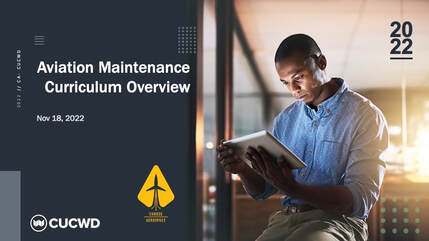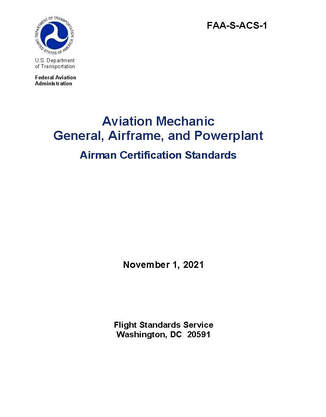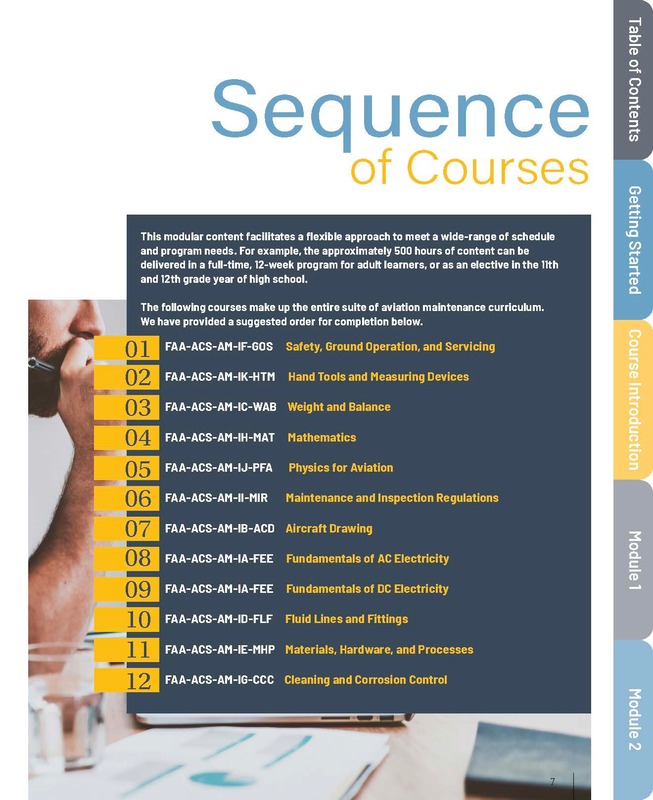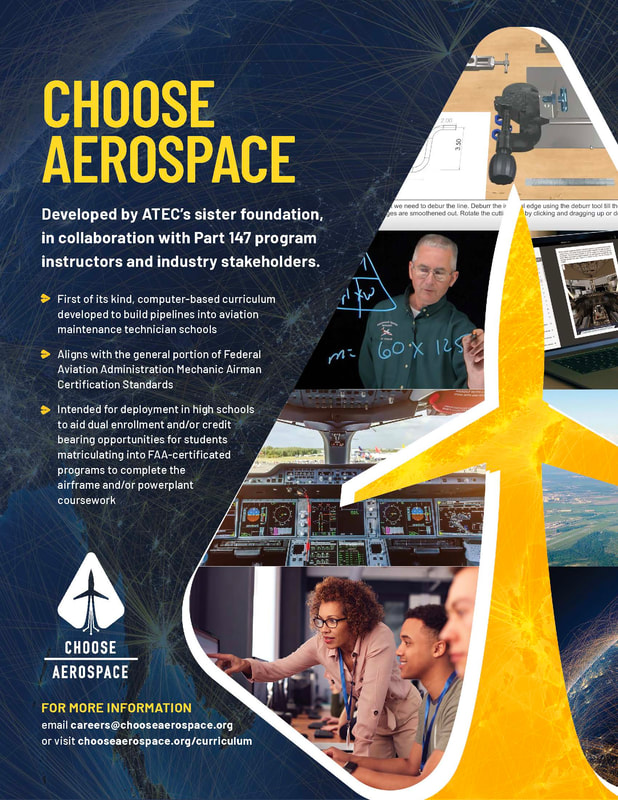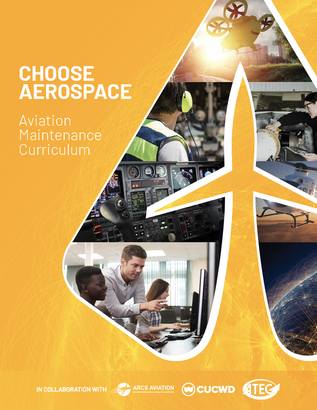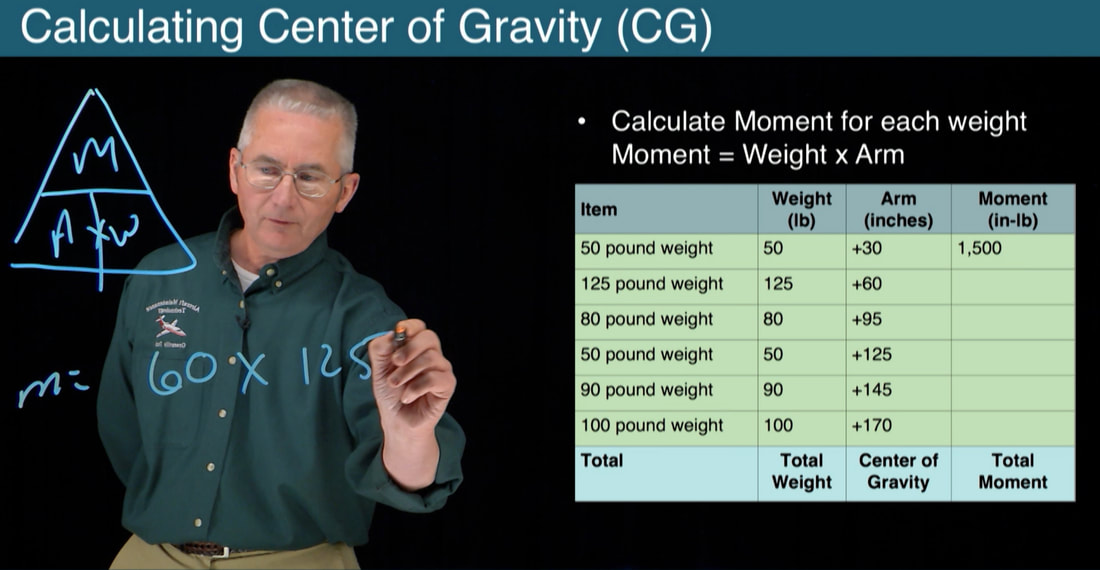|
Click to download slide deck presentation
|
aboutIn partnership with Clemson University Center for Workforce Development (CUCWD), ARCS Aviation, the Aviation Technician Education Council (ATEC), labor organizations, industry employers, and education partners, the Choose Aerospace aviation curriculum puts students on a direct path to FAA mechanic certification.
The approximately 500-hour curriculum was created to meet the rising demand for aviation technical personnel, and to facilitate career path development. the program is intended for use in a high school classroom (years 11 and 12), but the modular content facilitates a flexible approach to meet a wide-range of schedule and program needs. The content can be deployed in a variety of settings including community-based workforce development and veterans-to-work programs. |
|
Click to download FAA Mechanic ACS
|
CompetenciesThe Choose Aerospace curriculum aligns with emerging FAA Mechanic Airman Certification Standards (ACS) to cover the general knowledge and skill required for FAA mechanic certification.
Curriculum subjects cover every one of the knowledge, skill, and risk mitigation elements set forth in the general portion of the ACS (the curriculum does not cover the airframe or powerplant subjects). A spreadsheet showing where each general ACS element is addressed in the Choose Aerospace aviation maintenance curriculum is available here. |
Resources RequiredInternet. The content is computer-based, no special hardware or software is required. Virtual reality simulations included in the curriculum run off Unity3D WebGL, the list of suggested browsers is available here. Firefox or Chrome are recommended.
Teacher. It is strongly recommended that the teacher have three years experience in a technical-related field. FAA mechanic certification and/or aviation experience is a plus but not required. Training. Teachers are expected to attend professional development seminars once a year. The annual teacher training is a requirement for new teachers. More information is available on the Events page. Equipment and Materials. Adoption of hands-on labs set forth in the course guides are encouraged but not required. A full list of recommended equipment and materials will be provided upon application acceptance and onboarding. License Fee. User license fees are $200 per student, per year. |
syllabusThe curriculum is made up of twelve courses (click the link to download the course syllabus):
|
|
Click to download flyer
|
pathwaysStudents that complete the Choose Aerospace coursework can pursue FAA mechanic or repairman certification through work experience or by finishing the required coursework at one of 190 Federal Aviation Administration (FAA)-certificated aviation maintenance schools.
Programs are encouraged to define local pathways for their students, either through matriculation agreements with FAA-certificated programs or direct-hire agreements with local aviation companies. Choose Aerospace personnel are available to help facilitate these relationships. Common questions surrounding acceptance of credit for FAA-certificated part 147 programs are addressed on the Q&A page. |
|
Click to download brochure
|
MARKETINGMaterials are available to help programs market the aviation maintenance program offerings, including a brochure, slide deck (PPT version is available upon request), flyer, and parent letter.
Several resources are available to help illustrate the demand and opportunities available in aviation maintenance, including:
|
The PlatformThe Choose Aerospace Curriculum is powered by Clemson University Center for Workforce Development’s EducateWorkforce, an online learning system featuring premium, industry-tested course material that will help prepare learners for a technical career in aviation. The curriculum integrates Universal Design for Learning principles, multimodal content offerings, and state-of-the-art educational tools to make learning more accessible, efficient, and enjoyable.
It combines traditional delivery methods (classroom, textbook, and in-person labs) with e-learning methods (video lecture, e-book, virtual and augmented reality simulations and exercises) using a nationally deployable e-learning platform. |
|
Virtual Reality Simulations
Nearly 400 virtual reality simulations serve as online labs, where learners can go beyond the lecture to immerse themselves in the material. The technology simulates practical activities, such as fueling a plane, and visualizations of abstract content, such as the flow of air over an airplane wing. Samples:
|
|
|
Video Lectures
Nearly 150 micro lectures are presented through engaging video for visual and auditory learners, complete with illustrations, images, and voiceover. Subtitles are also provided for increased accessibility.
|
|
|
Interactive Assessments
All learning material is supported by interactive assessments aligned to the learning objectives. Many assessments provide students the opportunity to engage in higher order thinking skills. Immediate feedback as well as instructor-led grading systems are both available.
|
|
|
Open Textbooks
Robust open text is incorporated, including the FAA’s General Aviation Maintenance Technician Handbook (FAA-H-8083-30A). Students can access this text within the platform, even linking directly to the related content page from a given lesson. A copy of a traditional textbook complements the auditory and kinesthetic aspects of the curriculum.
|
|
